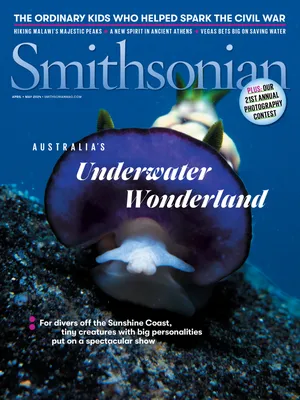The world’s smallest bear weighs as little as 60 pounds when fully grown, but it exerts a mighty influence on the patches of rainforest it inhabits across mainland Southeast Asia and the islands of Sumatra and Borneo. “Sun bears are forest engineers,” says Roshan Guharajan, a researcher with the conservation organization Panthera in Malaysian Borneo. Wong Siew Te, founder of the Bornean Sun Bear Conservation Center, calls them “forest doctors.”
They use powerful jaws and canines as large as a polar bear’s to bite chunks out of trees to access beehives, slurping the honey with a tongue that can stretch to ten inches long. The hollows they create provide new habitat for other arboreal forest dwellers such as flying squirrels or hornbills. Their short, muscled limbs and four-inch claws can break apart rotting logs for grubs and beetles, and dig for worms, boosting decomposition and cycling nutrients in the thin topsoil. And when fruits such as figs or even spiky durian are available, the bears feast on the cornucopia and disperse the seeds in their droppings as they roam, helping the forest regenerate. When fruit isn’t in season, they ransack termite nests, protecting the trees from the destructive insects.
In recent decades, however, their tropical forest homes have been slashed for timber and cleared to create palm oil plantations, especially in Malaysia and Indonesia. The bears are also poached for parts—their gallbladders contain bile used in traditional Chinese medicine, and their paws are a culinary delicacy—and they are even captured for the exotic pet trade. As a result, sun bear populations have plummeted by an estimated 35 percent or more in the last three decades.
But the bears are woefully understudied. With no reliable estimates of their global population or current distribution, conservationists are sometimes forced to guess where to protect rainforest habitat or crack down on poaching. That’s why later this year members of the International Union for Conservation of Nature’s Bear Specialist Group will launch a new initiative to create an updated range map for this little-studied species. The effort will combine new data from camera traps, field surveys and input from hundreds of experts across Southeast Asia to determine local sun bear presence. It will also use confirmed bear sightings to create a computer model that predicts where else bears “should be” by looking for environmental commonalities—attributes such as tree cover, tree species, forest age and elevation, and the locations of roads and protected area boundaries.
The specialist group will use the resulting updated range map to identify the highest-priority areas for sun bear conservation—for example, flagging emerging deforestation threats, identifying dangerously small populations and spotting corridors that could connect isolated bear habitats. “Sun bear populations could be blinking out in many small forest patches unbeknownst to us,” Dave Garshelis, co-chair of the specialist group, says. “We need this information to highlight where direct conservation actions should be focused.”
:focal(2416x1818:2417x1819)/https://tf-cmsv2-smithsonianmag-media.s3.amazonaws.com/filer_public/64/ac/64ace407-3b41-43d3-816a-b26e72920bee/img-611080-malaysian-sun-bear-malaysia-sebastian-kennerknecht.jpg)

/https://tf-cmsv2-smithsonianmag-media.s3.amazonaws.com/accounts/headshot/alex.png)